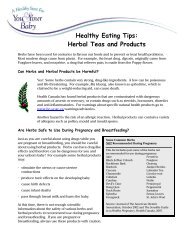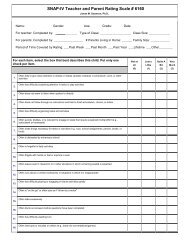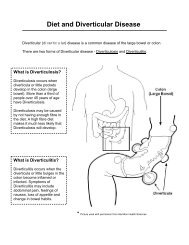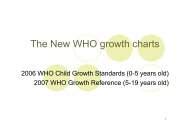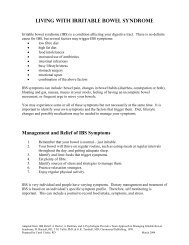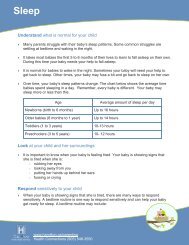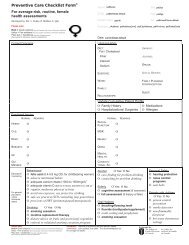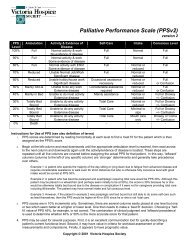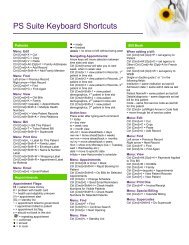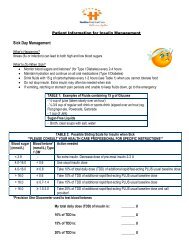The Yale-Brown Obsessive Compulsive Scale - Hamilton Family ...
The Yale-Brown Obsessive Compulsive Scale - Hamilton Family ...
The Yale-Brown Obsessive Compulsive Scale - Hamilton Family ...
You also want an ePaper? Increase the reach of your titles
YUMPU automatically turns print PDFs into web optimized ePapers that Google loves.
<strong>The</strong> <strong>Yale</strong>-<strong>Brown</strong> <strong>Obsessive</strong> <strong>Compulsive</strong> <strong>Scale</strong><br />
I. Development, Use, and Reliability<br />
Wayne K. Goodman, MD; Lawrence H. Price, MD; Steven A. Rasmussen, MD; Carolyn Mazure, PhD;<br />
Roberta L. Fleischmann, RN, BSN; Candy L. Hill, MS; George R. Heninger, MD; Dennis S. Charney, MD<br />
\s=b\<strong>The</strong> <strong>Yale</strong>-<strong>Brown</strong> <strong>Obsessive</strong> <strong>Compulsive</strong> <strong>Scale</strong> was designed<br />
to remedy the problems of existing rating scales by providing a<br />
specific measure of the severity of symptoms of obsessivecompulsive<br />
disorder that is not influenced by the type of obsessions<br />
or compulsions present. <strong>The</strong> scale is a clinician-rated, 10-$<br />
item scale, each item rated from 0 (no symptoms) to 4 (extreme<br />
symptoms) (total range, 0 to 40), with separate subtotals for<br />
severity of obsessions and compulsions. In a study involving<br />
four raters and 40 patients with obsessive-compulsive disorder<br />
at various stages of treatment, interrater reliability for the total<br />
<strong>Yale</strong>-<strong>Brown</strong> <strong>Scale</strong> score and each of the 10 individual items was<br />
excellent, with a high degree of internal consistency among all<br />
item scores demonstrated with Cronbach's \g=a\coefficient. Based<br />
on pretreatment assessment of 42 patients with obsessive-compulsive<br />
disorder, each item was frequently endorsed and measured<br />
across a range of severity. <strong>The</strong>se findings suggest that the<br />
<strong>Yale</strong>-<strong>Brown</strong> <strong>Scale</strong> is a reliable instrument for measuring the<br />
severity of illness in patients with obsessive-compulsive disorder<br />
with a range of severity and types of obsessive-compulsive<br />
symptoms.<br />
(Arch Gen Psychiatry. 1989 ;46:1006-1011)<br />
Accepted for publication August 25,1988.<br />
From the Department of Psychiatry, <strong>Yale</strong> University School of Medicine and<br />
<strong>The</strong> Connecticut Mental Health Center, Ribicoff Research Facilities, New<br />
Haven, Conn (Drs Goodman, Price, Mazure, Heninger, and Charney, and Mss<br />
Fleischmann and Hill); and the Department of Psychiatry, <strong>Brown</strong> University<br />
School of Medicine, Butler Hospital, Providence, RI (Dr Rasmussen).<br />
Reprint requests to Department of Psychiatry, <strong>Yale</strong> University School of<br />
Medicine, <strong>The</strong> Connecticut Mental Health Center, 34 Park St, New Haven, CT<br />
06508 (Dr Goodman).<br />
<strong>The</strong> recent recognition that obsessive-compulsive disorder<br />
(OCD) is not uncommon,1 coupled with the need to test<br />
new treatments for OCD, underscores the importance of reli¬<br />
able and valid outcome measures. To date, assessment of drug<br />
efficacy in OCD has been hampered by the shortcomings of<br />
existing rating instruments. In particular, there is need for an<br />
instrument that is sensitive to and selective for changes in<br />
severity of obsessive-compulsive symptoms. <strong>The</strong> absence of a<br />
broadly accepted scale for OCD also makes it difficult to<br />
compare the results of different treatment trials.<br />
A number of rating instruments have been used in the<br />
assessment of OCD, but all have serious limitations. <strong>The</strong><br />
instruments most widely used in the evaluation of adults are<br />
the Leyton Obsessional Inventory," the Maudsley Obsessional<br />
<strong>Compulsive</strong> Inventory,5,6 the <strong>Obsessive</strong> <strong>Compulsive</strong> Subscale<br />
of the Comprehensive Psychopathological Rating<br />
<strong>Scale</strong>,7'8 and the National Institutes of Mental Health Global<br />
<strong>Obsessive</strong> <strong>Compulsive</strong> <strong>Scale</strong>.910 Some interrater reliability<br />
data are available for these scales, but either their validity has<br />
not been established, or they are not suitable for drug treat¬<br />
ment studies. For example, the original rater-assisted version<br />
of the Leyton Obsessional Inventory is cumbersome to admin¬<br />
ister,2 and both the Leyton Obsessional Inventory3,4 and the<br />
Maudsley Obsessional <strong>Compulsive</strong> Inventory rely<br />
on self-rat¬<br />
ings, confound measurement of trait with state variables, and<br />
examine only certain types of obsessions and compulsions. A<br />
major drawback of the <strong>Obsessive</strong> <strong>Compulsive</strong> Subscale of the<br />
Comprehensive Psychopathological Rating <strong>Scale</strong> is that it<br />
contains items that rate symptoms (eg, depression) not specif¬<br />
ic to OCD. <strong>The</strong> <strong>Obsessive</strong> <strong>Compulsive</strong> Subscale ofthe Compre¬<br />
hensive Psychopathological Rating <strong>Scale</strong> was not designed de<br />
novo to assess OCD, but was derived from a factor analysis of<br />
the parent scale, the Comprehensive Psychopathological Rat¬<br />
ing <strong>Scale</strong>. A weakness of the National Institute of Mental<br />
Health <strong>Obsessive</strong> <strong>Compulsive</strong> <strong>Scale</strong> is characteristic of all<br />
single-item global measures of severity, namely, information<br />
about severity and response of individual symptoms of OCD is<br />
lost because the scale score cannot be resolved into separate<br />
components.<br />
<strong>The</strong> <strong>Yale</strong>-<strong>Brown</strong> <strong>Obsessive</strong> <strong>Compulsive</strong> <strong>Scale</strong> (Y-BOCS) was<br />
designed to remedy the problems of existing scales by provid¬<br />
ing a specific measure of the severity of symptoms of OCD (as<br />
defined by DSM-III-R) that is not influenced by the type or<br />
number of obsessions or compulsions present. In contrast to<br />
other rating scales, assessment of OCD severity with the Y-<br />
BOCS does not focus on the content of a patient's symptoms.<br />
<strong>The</strong> development, use, and reliability of the Y-BOCS are dis¬<br />
cussed herein, as are the psychometric properties ofindividual<br />
Y-BOCS items. Studies of scale validity are described else¬<br />
where.11<br />
DEVELOPMENT AND DESIGN<br />
Item selection was based on the extensive clinical experi¬<br />
ence of the principal developers of the Y-BOCS (W.K.G.,<br />
S.A.R., and L.H.P), who collectively have examined more<br />
than 300 patients with OCD. Several versions ofthe scale were<br />
piloted over a 6-month period until the current form (first<br />
edition) was finalized. To maximize specificity for OCD, an<br />
Downloaded from www.archgenpsychiatry.com at McMaster University, on June 29, 2011
.<br />
YALE-BROWN OBSESSIVE COMPULSIVE SCALE*<br />
None<br />
Mild Moderate Severe Extreme<br />
1. TIME SPENT ON OBSESSIONS<br />
2. INTERFERENCE FROM OBSESSIONS<br />
0<br />
0<br />
3<br />
DISTRESS OF OBSESSIONS<br />
0<br />
RESISTANCE<br />
Definitely<br />
resists<br />
0 1<br />
Completely<br />
yields<br />
4<br />
CONTROL OVER OBSESSIONS<br />
Complete<br />
control<br />
o<br />
Much<br />
control<br />
1<br />
Moderate<br />
control<br />
2<br />
Little<br />
control<br />
3<br />
No<br />
control<br />
4<br />
6. TIME SPENT ON COMPULSIONS<br />
7. INTERFERENCE FROM COMPULSIONS<br />
8. DISTRESS FROM COMPULSIONS<br />
RESISTANCE<br />
Definitely<br />
resists<br />
0 1<br />
Completely<br />
yields<br />
4<br />
10. CONTROL OVER COMPULSIONS<br />
Complete<br />
control<br />
0<br />
Much<br />
control<br />
Moderate<br />
control<br />
2<br />
Lillle<br />
control<br />
3<br />
No<br />
control<br />
4<br />
*<br />
A complete Iranscript of item probes and anchor points is available on request. For example<br />
item 10 is as follows:<br />
the full version of<br />
10. DEGREE OF CONTROL OVER COMPULSIVE BEHAVIOR<br />
How strong is the drive to perform the compulsive behavior? (pause) How<br />
much control do you have over the compulsions? (In contrast to the<br />
preceding item on resistance, the ability of the patient to control his<br />
compulsions is more closely related to the severity of the compulsions)<br />
0 =<br />
Complete control.<br />
1 Much control, experience = pressure to perform the behavior, but usually able to<br />
exercise voluntary control over it.<br />
2 = Moderate control, strong pressure to perform behavior, can control it only with<br />
difficulty.<br />
3 = Little control, very strong drive to perform behavior, must be carried to<br />
completion, can only delay with difficulty.<br />
4 =<br />
No control, drive to perform behavior experienced as completely involuntary<br />
and overpowering, rarely able to even momentarily delay activity._<br />
Fig 1.—Answer key for the 10-item <strong>Yale</strong>-<strong>Brown</strong> <strong>Obsessive</strong> <strong>Compulsive</strong> <strong>Scale</strong> and the complete text for item 10.<br />
attempt was made to exclude items that seemed to reflect<br />
symptoms of depression or other anxiety disorders, lb en¬<br />
hance the sensitivity ofthe Y-BOCS to change, items intended<br />
to measure putative state variables were included in the core<br />
portion ofthe Y-BOCS, while items believed to reflect person¬<br />
ality traits (eg, perfectionism) were excluded. Certain clinical<br />
features commonly associated with OCD, but not clearly relat¬<br />
ed to the severity of the illness, were assessed by items in the<br />
investigational component of the Y-BOCS.<br />
<strong>The</strong> Y-BOCS is a 10-item clinician-rated scale, each item<br />
rated from 0 (no symptoms) to 4 (extreme symptoms) (Fig 1)<br />
(complete copy available on request). <strong>The</strong> Y-BOCS was de¬<br />
signed as an observer-rated instrument because of evidence<br />
from assessment of other disorders that ratings based on selfreport<br />
alone, particularly during acute stages of illness, corre¬<br />
late poorly with more objective evaluations.1213 For all items,<br />
higher numerical a<br />
score corresponds to greater illness sever¬<br />
ity. <strong>The</strong> total Y-BOCS score is the sum of items 1 to 10 (range,<br />
0 to 40). <strong>The</strong>re are separate subtotals for severity of obses¬<br />
sions (sum ofitems 1 through 5) and compulsions (sum of items<br />
6 through 10). Symptoms are assessed with regard to how<br />
much they occupy the patient's time, interfere with normal<br />
functioning, cause subjective distress, are actively resisted by<br />
the patient, and can actually be controlled by the patient.<br />
Thus, the core items (1 to 10) of the Y-BOCS measure the<br />
severity of the cardinal symptoms of OCD (ie, obsessions and<br />
compulsions) along the dimensions of time, interference, dis¬<br />
tress, resistance, and control.<br />
<strong>The</strong> rationale for including items 1 to 3 and 6 to 8 was<br />
relatively straightforward; the degree to which obsessions or<br />
compulsions occupy the patient's time, interfere with func¬<br />
tioning, or cause distress were considered directly related to<br />
severity of illness. To safeguard the specificity of the Y-BOCS<br />
in measuring the severity of OCD, the instructions corre¬<br />
sponding to these items were designed to aid the rater in<br />
excluding consideration of other (non-OCD) symptoms. For<br />
example, item 4 (distress from obsessions) instructs the inter¬<br />
viewer to "only rate anxiety that seems triggered by obses¬<br />
sions, not generalized anxiety or anxiety associated with other<br />
symptoms."<br />
Items 4 and 9, which respectively measure the degree of<br />
resistance to obsessions and compulsions, deserve further<br />
description because several other rating scales have defined<br />
"resistance" differently.3,9 In the Y-BOCS, resistance is a<br />
Downloaded from www.archgenpsychiatry.com at McMaster University, on June 29, 2011
Table 1.-Interrater Reliability: Mean Y-BOCS Total and<br />
Subtotal Scores for Four Raters of 40 Patients With<br />
<strong>Obsessive</strong> <strong>Compulsive</strong> Disorder*<br />
Rater<br />
Scorest W.G. L. P. R. F. C H.<br />
Obsession subtotal<br />
Mean ± SD 10.7±4 10.6±4 10.6±5 10.8±5<br />
Range 0 = 18 0 20 = 0 19 = 0 19<br />
=<br />
Compulsion subtotal<br />
Mean ± SD 11.1 ±4 11.1 ±4 11.4±4 11.3±4<br />
Range 0 18 = 0=19 0 19 = 0 19<br />
=<br />
Y-BOCS total<br />
Mean ± SD 21.8±8 21.7 + 8 21.9±8 22.1 ±8<br />
Range 2 34 = 1=37 4 36 = 2 36<br />
=<br />
Patients were at various stages of treatment. Y-BOCS indicates <strong>Yale</strong>-<br />
<strong>Brown</strong> <strong>Obsessive</strong> <strong>Compulsive</strong> <strong>Scale</strong>.<br />
tObsession subtotal scores were the sum of items 1 through 5, compulsion<br />
subtotal scores were the sum of items 6 through 10, and Y-BOCS total was<br />
the sum of items 1 through 10.<br />
W.G.<br />
L. P.<br />
R. F.<br />
C.H.<br />
Raters<br />
W.G. L. P. R. F. C. H.<br />
r=.97595<br />
P-c.0001<br />
r=. 97855<br />
P
Table 2.—Interrater Reliability: Intraclass Correlation<br />
Coefficients (ICCs) for Four Raters of 40 Patients With<br />
<strong>Obsessive</strong> <strong>Compulsive</strong> Disorder<br />
ICCst<br />
Y-BOCS items*<br />
1 .95<br />
2 .96<br />
3 .92<br />
4 .90<br />
5 .93<br />
6 .91<br />
7 .97<br />
8 .88<br />
9 .93<br />
10 .86<br />
Obsession subtotal<br />
(sum of items 1-5) .97<br />
Compulsion subtotal<br />
(sum of items 6-10) .96<br />
Total (sum of items 1-10) .98<br />
*Y-BOCS indicates <strong>Yale</strong>-<strong>Brown</strong> <strong>Obsessive</strong> <strong>Compulsive</strong> <strong>Scale</strong>.<br />
tAII correlations are highly significant at P-c.0001.<br />
Table 4.—Correlation of Individual Items With Total <strong>Yale</strong>-<br />
<strong>Brown</strong> <strong>Obsessive</strong> <strong>Compulsive</strong> <strong>Scale</strong> (Y-BOCS) Score<br />
Item<br />
1 .44
etween the research associate (C.H.) and one of the psychiatrists<br />
(W.K.G.) was .98 (Fig 2). <strong>The</strong> lowest pairwise Pearson correlation<br />
coefficients for the obsession and compulsion subtotals were .95 and<br />
.96, respectively (P
differential effects on obsessions or compulsions. <strong>The</strong> subto¬<br />
tals of the Y-BOCS for obsessions (sum of items 1 through 5)<br />
and compulsions (sum of items 6 through 10) permit the treat¬<br />
ment response of obsessions and compulsions to be separately<br />
evaluated and compared.<br />
<strong>The</strong>se studies confirm the ability of the Y-BOCS to reliably<br />
rate the severity of obsessive-compulsive symptoms in pa¬<br />
tients with OCD with a wide range of severity and symptom<br />
types. This was reflected in excellent interrater reliability for<br />
the total Y-BOCS score and the 10 individual items. <strong>The</strong>re was<br />
a high degree ofinternal consistency and all items were signifi¬<br />
cantly correlated with the total Y-BOCS score. <strong>The</strong> direction<br />
References<br />
of ratings on the resistance items conformed to expectations,<br />
with higher scores (less effort resisting symptoms) associated<br />
with more severe illness. <strong>The</strong> primary use of the Y-BOCS is in<br />
rating the severity of OCD, with particular emphasis on the<br />
ability to reflect changes in severity during treatment. Valida¬<br />
tion of the Y-BOCS for this application is addressed else¬<br />
where.11<br />
<strong>The</strong>se studies were supported in part by a grant from Ciba-Geigy Corp,<br />
Summit, NJ; by National Institute of Mental Health grants MH-25642, MH-<br />
30929, MH-36229, MH-00579; and by the State of Connecticut.<br />
<strong>The</strong> authors thank the research, clinical, and clerical staffs of the Clinical<br />
Neuroscience Research Unit and Richard Katz, PhD, of Ciba-Geigy Corp for their<br />
expert assistance. Michael Kozak, PhD, kindly reviewed the manuscript.<br />
1. Robins LN, Helzer JE, Weissman MM, Orvaschel H, Gruenberg E, Burke<br />
JD, Regier DA. Lifetime prevalence of specific psychiatric disorders in three<br />
sites. Arch Gen Psychiatry. 1984;41:949-958.<br />
2. Cooper J. <strong>The</strong> Leyton Obsessional Inventory. Psychol Med. 1970;1:48\x=req-\<br />
64.<br />
3. Allen JJ, Tune GS. <strong>The</strong> Lynfield Obsessional <strong>Compulsive</strong> Questionnaire.<br />
Scott Med J. 1975;20(suppl 1):21-24.<br />
4. Snowdon JA. A comparison of written and postbox forms of the Leyton<br />
Obsessional Inventory. Psychol Med. 1980;10:165-170.<br />
5. Hodgson RJ, Rachman S. Obsessional-compulsive complaints. Behav Res<br />
<strong>The</strong>r. 1977;15:389-395.<br />
6. Rachman SJ, Hodgson RJ. Obsessions and Compulsions. Englewood<br />
Cliffs, NJ: Prentice-Hall Inc; 1980.<br />
7. Asberg M, Montgomery SA, Perris C, Schalling D, Sedvall G. A comprehensive<br />
psychopathological rating scale. Acta Psychiatr Scand. 1978;<br />
271(suppl):5-27.<br />
8. Thoren P, Asberg M, Cronholm B, Jornestedt L, Traskman L. Clomipramine<br />
treatment of obsessive-compulsive disorder, I: a controlled clinical trial.<br />
Arch Gen Psychiatry. 1980;37:1281-1285.<br />
9. Insel TR, Murphy DL, Cohen RM, Alterman I, Kilts C, Linnoila M.<br />
<strong>Obsessive</strong>-compulsive disorder: a double-blind trial of clomipramine and clorgyline.<br />
Arch Gen Psychiatry. 1983;40:605-612.<br />
10. Murphy DL, Pickar D, Alterman IS. Methods for the quantitative assessment<br />
ofdepressive and manic behavior. In: Burdock EI, Sudilovsky A, Gershon<br />
S, eds. <strong>The</strong> Behavior of Psychiatric Patients. New York, NY: Marcel Dekker<br />
Inc; 1982:355-392.<br />
11. Goodman WK, Price LH, Rasmussen SA, Mazure C, Delgado P, Heninger<br />
GR, Charney DS. <strong>Yale</strong>-<strong>Brown</strong> <strong>Obsessive</strong>-<strong>Compulsive</strong> <strong>Scale</strong>, II: validity.<br />
Arch Gen Psychiatry. 1989;46:1012-1016.<br />
12. Prusoff BA, Klerman GL, Paykel ES. Concordance between clinical<br />
assessments and patients' self-report in depression. Arch Gen Psychiatry.<br />
1972;26:546-552.<br />
13. Mazure C, Nelson JC, Price LH. Reliability and validity ofthe symptoms<br />
of major depressive illness. Arch Gen Psychiatry. 1986;43:451-456.<br />
14. Bartko JJ, Carpenter WT Jr. On the methods and theory of reliability. J<br />
Nerv Ment Dis. 1976;163:307-316.<br />
15. Anastasi A. Psychological Testing. 5th ed. New York, NY: MacMillan<br />
Publishing Co Inc; 1982.<br />
16. Cronbach LJ. Coefficient alpha and the internal structure of tests. Psychometrika.<br />
1951;16:297-334.<br />
17. Bartko JJ. <strong>The</strong> intraclass correlation coefficient as a measure of reliability.<br />
Psychol Rep. 1966;19:3-11.<br />
18. Bartko JJ. On various intraclass correlation reliability coefficients. Psychol<br />
Bull. 1976;83:762-765.<br />
19. Cohen J, Cohen P. Applied Multiple Regression Correlation Analysis<br />
for the Behavioral Sciences. Hillsdale, NJ; Lawrence Erlbaum Associates;<br />
1975.<br />
20. Price LH, Goodman WK, Charney DS, Rasmussen SA, Heninger GR.<br />
Treatment of severe obsessive-compulsive disorder with fluvoxamine. Am J<br />
Psychiatry. 1987;144:1059-1061.<br />
21. Goodman WK, Price LH, Rasmussen SA, Delgado PL, Heninger GR,<br />
Charney DS. Efficacy of fluvoxamine in obsessive-compulsive disorder: a double-blind<br />
comparison with placebo. Arch Gen Psychiatry. 1989;46:36-44.<br />
22. O'Hara MW, Rehm LP. <strong>Hamilton</strong> Rating <strong>Scale</strong> for Depression: reliability<br />
and validity ofjudgments of novice raters. J Consult Clin Psychol. 1983;51:318\x=req-\<br />
319.<br />
23. Rasmussen SA, Tsuang MT. Clinical characteristics and family history in<br />
DSM-III obsessive-compulsive disorder. Am JPsychiatry. 1986;143:317-322.<br />
24. Thomas CS. Dysmorphophobia: a question of definition. Br J Psychiatry.<br />
1984;144:513-516.<br />
Downloaded from www.archgenpsychiatry.com at McMaster University, on June 29, 2011




